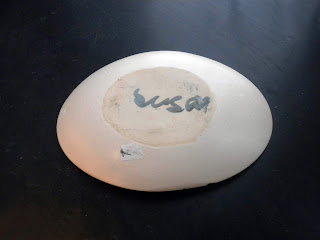This bowl is an original one of a kind object created by Brenda Nash Andersen
The portrait is of Susan, the second eldest daughter, which is myself, author of this description. I look to be about the age I was when our family moved to Maine, dating this bowl at 1952.
Andersen Design remained an American made ceramic studio at a time when most of the western ceramic industry moved production to foreign labor markets. The company competed successfully in a market flooded with foreign made imports, producing a hand-made art product affordable to the middle class. The work was collected by Americans of every walk of life and collections handed down through the generations.
There is a debate as to whether it is a portrait of Karen, the eldest daughter or Gerda, the third daughter. While I agree that it looks more like Gerda than Karen, the similarity of the signatures with the bowl above, which is clearly a portrait of Susan and not Elise, since Susan and Elise have distinctly different eyes and hair. Susan’s hair was always curly, and Elise’s hair was straight. The signature of the two bowls are almost identical.
The bowls are dated by the signatures on the bottom in which “Andersen” is spelled the Swedish way, as “Anderson”. Weston’s family is Danish but when they first migrated to America someone changed the spelling of “Andersen” to “Anderson”. Weston changed the spelling back to “Andersen” in the fifties but this bowl has the signature signed with an “O” indicating that it was done at a very early date and that the portrait is of Karen, the eldest daughter.
That point made, it can be a mistake to identify a work by the signature on the bottom. For years I thought This work of a girl jump roping was by my mother. It is true it has a child like aspect to it, but mother had such a character that it did not seem implausible that she could have created this piece and her signature is on the bottom:
However when we started reviewing pieces known to have been done by myself as a child, the theme emerged that I painted wreaths around the characters. It then became more plausible that my mother signed the bottoms of the platters before she painted them. I came along and did my own art work on a platter which my mother had already signed, making the girl jumping rope a self portrait by this author.
Andersen Design remained an American made ceramic studio when most of the western ceramic industry moved production to foreign labor markets and competed successfully in a market flooded with foreign made imports, producing a hand-made art product affordable to the middle class. Andersen Design stands as a singular American original design company taking the road less travelled during an era of global transformation.









